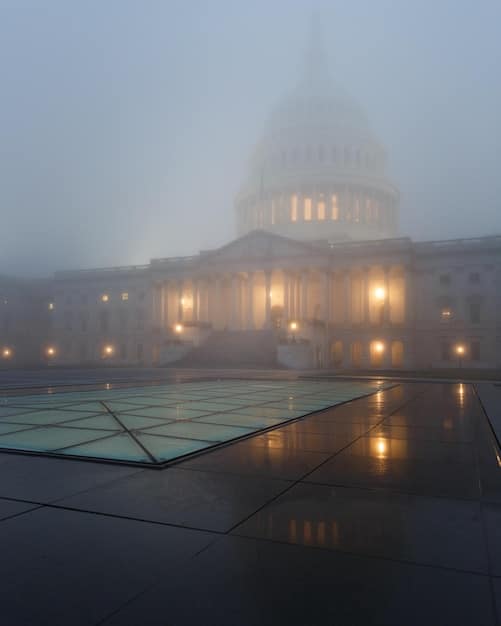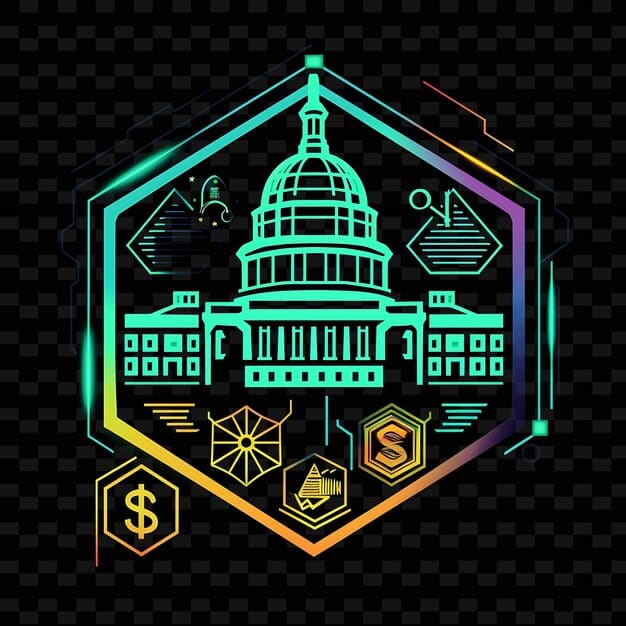US Government Shutdown Looms: Federal Services at Risk

A potential US government shutdown is imminent as budget negotiations remain stalled, threatening significant disruptions to federal services and impacting millions of Americans nationwide.
As the clock ticks down, the prospect of a government shutdown imminent as budget negotiations stall – impact on federal services becomes an increasingly alarming reality for millions of Americans. This precarious situation, born from a deadlock in congressional funding talks, casts a long shadow over essential government operations and the livelihoods of federal employees.
Understanding the Mechanics of a Government Shutdown
A government shutdown occurs when Congress fails to pass appropriation bills, or a continuing resolution, to fund government operations for the upcoming fiscal year. Without allocated funds, non-essential government agencies must cease operations, and “non-essential” federal employees are furloughed.
This isn’t a new phenomenon in American politics, but each occurrence brings unique challenges and consequences. The underlying causes typically involve deep ideological divides over spending priorities or policy riders attached to funding legislation.
Historical Context of US Government Shutdowns
The history of US government shutdowns is marked by periods of intense political brinkmanship. While the Antideficiency Act, which largely prohibits federal agencies from obligating funds in advance of an appropriation, dates back to 1884, its strict enforcement regarding shutdowns only began around 1980.
- 1995-1996 Shutdowns: Two shutdowns during the Clinton administration, primarily over budget disputes with congressional Republicans, led to significant public backlash and economic disruption.
- 2013 Shutdown: A 16-day shutdown occurred over the Affordable Care Act, resulting in a estimated $2 billion impact on the US economy.
- 2018-2019 Shutdown: The longest in US history, lasting 35 days, driven by a dispute over border wall funding. It had widespread impacts on federal services and employee morale.
Each episode underscores the fragility of the legislative process when consensus cannot be reached, often leaving the public to bear the brunt of political disagreements.
The current impasse reflects familiar patterns: a divided Congress grappling with divergent fiscal priorities, compounded by the urgency of a looming deadline. The implications of a funding lapse extend far beyond the abstract concept of government, touching the daily lives of citizens.
Ultimately, a shutdown is a symptom of a deeper political dysfunction, where compromise proves elusive, and the operational stability of the nation’s government hangs precariously in the balance.
Key Agencies and Services at Immediate Risk
When a government shutdown occurs, the immediate question on many minds is which services will be affected. While “essential” services like national security and public safety typically continue, a vast array of federal operations deemed “non-essential” face immediate suspension or significant curtailment.
Critical government functions that underpin daily life for millions can be disrupted. This includes everything from passport processing to scientific research and elements of environmental protection. The very fabric of public administration begins to fray.

Federal Departments Facing Furloughs and Service Disruptions
The specific impact varies depending on the duration of the shutdown and the nature of each agency’s functions. However, certain departments are consistently identified as being heavily affected:
- Department of Commerce: Impacts on economic data collection (e.g., Census Bureau) and weather forecasting through NOAA.
- Department of the Interior: National Parks and museums may close or have drastically reduced services, affecting tourism and recreational activities.
- Department of Housing and Urban Development (HUD): Delays in housing assistance and loan processing.
- Internal Revenue Service (IRS): Taxpayer assistance may be limited, and refund processing could be delayed, especially during peak seasons.
These disruptions can lead to ripple effects across various sectors of the economy and society. Small businesses reliant on federal permits or loans may face delays, and individuals awaiting critical government services could experience significant hardship.
Understanding which agencies are directly on the chopping block helps in anticipating the broader consequences for the public. It also highlights the intricate web of services that the federal government provides, often unnoticed until they are suddenly absent.
The uncertainty alone can lead to anxiety among federal employees and those who depend on their work. As the shutdown threat persists, the focus turns to mitigating these potential impacts wherever possible, though the scope of a full shutdown is vast and difficult to fully contain.
Economic Ripple Effects of a Prolonged Shutdown
A government shutdown is not merely a bureaucratic standstill; it’s an event with tangible economic consequences that can reverberate through national and even global markets. The immediate cessation of services and federal employee furloughs trigger a chain reaction that dampens economic activity.
The economic impact stems from various channels, including reduced government spending, decreased consumer confidence, and disruptions to critical business-related functions. Estimates from past shutdowns suggest significant economic losses, often measured in billions of dollars.
Impact on Federal Employees and Contractors
One of the most direct and human costs of a shutdown is the impact on federal employees and government contractors. Hundreds of thousands of “non-essential” employees are furloughed, meaning they are sent home without pay.
- Loss of Income: Furloughed employees face immediate financial hardship, potentially missing mortgage payments, rent, and other essential bills. While they often receive back pay after a shutdown ends, the uncertainty and interim financial strain are significant.
- Contracting Delays: Government contractors, who often employ millions of workers, also face uncertainty. Projects can be halted, payments delayed, and contracts put on hold, leading to job insecurity and potential layoffs in the private sector.
This reduction in household income for federal workers and contractors directly translates to a drop in consumer spending, which is a major driver of the US economy. Businesses in areas with high concentrations of federal employees often experience a downturn.
Beyond the immediate financial hit, there’s a significant psychological toll. The uncertainty and stress of a shutdown can lead to lower morale, impacting productivity and recruitment even after operations resume.
The cumulative effect of these individual economic struggles can dampen economic growth at a broader level, creating a drag on the nation’s GDP. The longer a shutdown lasts, the more entrenched these negative effects become.
Furthermore, disruptions to federal agencies that collect and disseminate vital economic data, such as the Census Bureau or the Bureau of Economic Analysis, can leave businesses and policymakers without the timely information needed for sound decision-making, adding another layer of economic uncertainty.
Impact on Public Services and Citizen Experience
Beyond the economic ramifications, a government shutdown fundamentally alters the daily experience of citizens interacting with their federal government. Services that many take for granted can suddenly become unavailable or severely limited, leading to frustration and inconvenience.
From delayed tax refunds to closed national parks, the tangible effects of a political impasse quickly become apparent to the American public. This erosion of service delivery can strain public trust and create significant bottlenecks.
Everyday Services Affected by a Funding Lapse
The list of disrupted services is extensive and touches various aspects of daily life. For instance, processes such as passport and visa applications might be delayed, causing issues for international travelers and immigrants.
- National Parks and Museums: Many national parks and monuments, as well as Smithsonian museums, may close or operate with vastly reduced staff, impacting tourism and recreational access.
- Food Safety and Inspections: While critical inspections often continue, non-essential administrative functions related to food safety could be curtailed, potentially raising concerns about oversight.
- Loan Processing: Applications for federal loans, such as those for housing (FHA, VA) or small businesses (SBA), may face significant processing delays, impacting home purchases and entrepreneurial ventures.
- Research and Development: Scientific research grants and projects funded by agencies like NASA or the National Institutes of Health may be put on hold, delaying critical advancements.
These examples illustrate how a seemingly remote political conflict can have very real and immediate consequences for ordinary citizens. The inconvenience can range from minor annoyances to significant financial or personal setbacks.
Moreover, the backlog created during a shutdown can take weeks or even months to clear once funding is restored. This means that even after the immediate crisis passes, the public may continue to experience delays and disruptions.
The cumulative effect of these service interruptions can diminish public confidence in the government’s ability to effectively deliver on its promises and maintain essential functions, underscoring the broader societal costs of political deadlock.
The Political Stalemate: Why Negotiations Have Stalled
The current threat of a government shutdown is not an isolated event but rather the culmination of deep-seated political disagreements. Understanding the core issues behind the stalled budget negotiations is crucial to grasping why a resolution remains so elusive.
At the heart of the impasse are fundamental differences in spending priorities, often exacerbated by partisan demands and the broader electoral landscape. Each side faces pressure from their respective political bases, making compromise difficult.

Core Disagreements and Sticking Points
While the specifics can shift, certain themes consistently emerge as stumbling blocks in budget negotiations:
- Spending Levels: Disagreements over the overall level of federal spending, particularly between those advocating for fiscal conservatism and those pushing for increased investment in social programs or infrastructure.
- Policy Riders: Often, controversial policy provisions are attached to appropriations bills. These “riders” can range from environmental regulations to social issues, and their inclusion (or exclusion) can trigger intense opposition and stall funding bills.
- Defense vs. Non-Defense Spending: A perennial debate exists over the allocation of funds between military and non-military programs, with staunch advocates on both sides.
- Party Line Demands: Members of both parties may face pressure from their caucuses or special interest groups to hold firm on certain demands, making it harder for leaders to broker bipartisan deals. For example, some factions may demand significant cuts to specific agencies, while others insist on increased funding for different priorities.
The interplay of these factors creates a highly complex negotiating environment. The outcome of upcoming elections also implicitly influences the urgency and willingness to compromise, as a shift in power could alter future budgetary landscapes.
Furthermore, the increased polarization in American politics means that even relatively minor disagreements can quickly escalate into full-blown crises, with each side wary of conceding ground that might be seen as a sign of weakness by their constituents.
The lack of a grand bargain or a clear path to consensus reflects a fundamental disconnect in congressional priorities, placing the operational stability of the government in a perpetually precarious position as deadlines approach.
Potential Paths to Resolution and Future Outlook
Despite the looming threat of a shutdown, history suggests that Congress will eventually find a way to fund the government. The question is how and at what cost. Several potential paths to resolution exist, each with its own set of challenges and political implications.
The resolution often comes down to one of three primary mechanisms: a grand bipartisan agreement, a series of short-term continuing resolutions, or, in some cases, one party capitulating after a shutdown has begun. The future outlook depends heavily on the willingness of both sides to compromise.
Strategies for Averting or Ending a Shutdown
When faced with a shutdown, political leaders typically employ several strategies to either prevent it or bring it to an end:
- Bipartisan Negotiations: The ideal scenario involves leaders from both parties finding common ground on spending levels and policy riders, crafting a compromise bill that can pass both chambers of Congress.
- Continuing Resolutions (CRs): These are short-term spending bills that keep the government funded at current levels for a specified period (e.g., a few weeks or months). CRs buy more time for full appropriations bills to be negotiated but don’t resolve the underlying issues.
- Omnibus Bills: Sometimes, multiple individual appropriations bills are bundled into one large “omnibus” package. This can make it easier to pass controversial spending, as the sheer size of the bill can incentivize lawmakers to vote for it despite objections to specific parts.
- Public Pressure: Often, the negative public reaction to a shutdown compels lawmakers to return to the negotiating table and find a resolution, as the political costs of inaction become too high.
The current situation likely involves a combination of these elements. A short-term CR might be used to avert an immediate shutdown, providing more time for a broader agreement to be reached, possibly through an omnibus bill.
However, the political climate remains tense, and the possibility of a prolonged shutdown cannot be dismissed. The lessons from past shutdowns emphasize that while resolutions eventually emerge, they often come after significant disruption and economic cost.
The long-term outlook for fiscal stability remains uncertain, highlighting the ongoing challenge of governing in a deeply divided political landscape. The ability of congressional leaders to broker effective compromises will determine the severity and duration of any future funding crises.
The experience of past shutdowns serves as a sobering reminder of the importance of proactive and collaborative governance to avoid unnecessary disruption. Navigating the delicate balance between ideological convictions and practical governance remains the paramount challenge for lawmakers.
| Key Concern | Brief Impact Description |
|---|---|
| 🏛️ Federal Services Disruption | Non-essential government operations (e.g., passport processing, park closures) may cease. |
| 💵 Economic Consequences | Furloughs for federal workers, delays in government contracts, and reduced consumer spending. |
| 🚫 Negotiation Stalemate | Deep partisan divisions over spending priorities and policy riders prevent budget agreement. |
| 📈 Future Outlook | Short-term resolutions (CRs) are likely but risk repeated crises without long-term compromise. |
Frequently Asked Questions About Government Shutdowns
▼
A government shutdown occurs when Congress fails to pass legislation to fund government operations for the upcoming fiscal year. Without an appropriation or a continuing resolution, “non-essential” federal agencies must cease operations, leading to furloughs for many employees and disruptions to services until funding is restored.
▼
Essential services typically continue during a shutdown. These include critical functions related to national security, public safety, and the protection of life and property. Examples are air traffic control, law enforcement (FBI, Border Patrol), military operations, and emergency medical services. Social Security and Medicare benefits usually continue as they are funded by separate mechanisms.
▼
Most “non-essential” federal employees are furloughed, meaning they are temporarily sent home without pay. “Essential” employees continue to work without pay, though they are usually compensated with back pay once the shutdown ends. Furloughed employees may or may not receive back pay, depending on subsequent legislation. This creates significant financial hardship and uncertainty.
▼
Economic consequences include a reduction in consumer spending due to furloughed federal workers, delays in government contracts impacting private companies, and disruptions to federal agencies that collect vital economic data. Past shutdowns have been estimated to cost billions of dollars, impacting GDP growth and overall economic confidence. The uncertainty also deters investment.
▼
Shutdowns are usually resolved when Congress passes either a full-year appropriations bill or a short-term continuing resolution (CR) to fund the government. Resolutions often emerge from bipartisan negotiations, sometimes after public pressure mounts due to the negative impacts. CRs provide temporary funding, buying more time for legislators to reach a comprehensive agreement.
The Path Forward: Navigating the Uncertainty
As the immediate threat of a government shutdown looms, the nation watches intently, bracing for potential disruptions to federal services and a ripple effect on the economy. This precarious situation underscores the critical need for political leaders to find common ground, prioritizing the functionality of government over partisan disputes. While the precise duration and comprehensive impacts of a shutdown remain uncertain until a resolution is reached, the historical context and potential consequences paint a clear picture of the stakes involved for millions of Americans.





